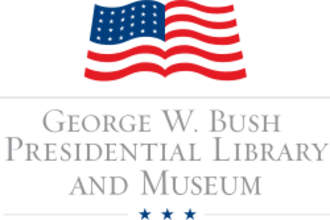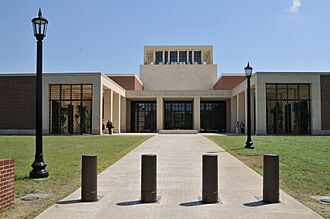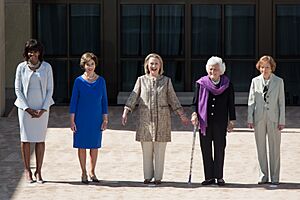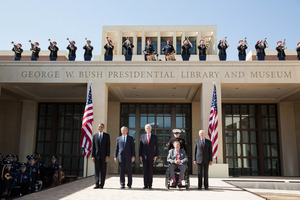George W. Bush Presidential Center facts for kids
Quick facts for kids George W. Bush Presidential Center |
|
|---|---|

Official logo of the George W. Bush Presidential Center
|
|

Policy Institute at George W. Bush Presidential Center
|
|
| General information | |
| Architectural style | New Classical |
| Location | 2943 SMU Boulevard, Dallas, TX 75205, United States - Southern Methodist University |
| Coordinates | 32°50′27″N 96°46′41″W / 32.8409°N 96.7781°W |
| Named for | George W. Bush |
| Construction started | November 16, 2010 |
| Completed | April 25, 2013 |
| Technical details | |
| Size | 207,000 square feet (19,200 m2) |
| Design and construction | |
| Architect | Robert A.M. Stern Architects |
The George W. Bush Presidential Center is a special place in University Park, Texas, near Dallas. It opened on April 25, 2013. This center holds the presidential library and museum for George W. Bush. He was the 43rd president of the United States from 2001 to 2009.
The center also includes the George W. Bush Policy Institute. It has offices for the George W. Bush Foundation. The entire complex is located on the campus of Southern Methodist University (SMU). It is also planned to be the burial site for George W. Bush and his wife, Laura Bush.
Contents
History of the Center
Choosing the Location
Who Wanted the Library?
Before George W. Bush became president, many universities wanted to host his presidential library. Baylor University in Waco, Texas, was one of the first to show interest. They thought their location near his ranch was a good idea.
After Bush became president, Southern Methodist University (SMU) in Dallas also started working on a plan. The White House waited until after Bush won his second term to discuss the library.
In late 2005, six colleges and one city were asked to submit proposals. These included Baylor, SMU, the University of Texas System, Texas Tech University, the University of Dallas, and Midland College. The city of Arlington, Texas, also made a bid. Midland College later joined with Texas Tech for a "West Texas Coalition" bid.
What Were the Options?
Each location had good points and bad points. Arlington offered land near sports stadiums. This area already attracted many tourists. However, it lacked strong university involvement.
Baylor University had a lot of land by the Brazos River. But Waco is not a big city. This meant fewer visitors might come each year.
The University of Texas System already had the Lyndon Baines Johnson Library and Museum. This gave them experience. However, some people at the university did not want the Bush library there. Their idea was to split the library across several campuses. This would create a "virtual" library.
Texas Tech University had plenty of land and support. But like Baylor, it was not in a major city.
The University of Dallas (UD) is a private school. It had undeveloped land near major highways. This land was also close to a future train station.
SMU's plan was a bit of a secret at first. SMU bought many homes and businesses nearby to get enough land. Some neighbors were worried about traffic and tour buses. Despite this, the local town council agreed to sell parkland to SMU.
Final Choices and Decision
In late 2005, SMU, Baylor, UD, and Texas Tech were chosen as finalists. They presented their plans in Washington. Soon after, Texas Tech was no longer considered. This left SMU, Baylor, and UD.
On December 20, 2006, a judge ruled in favor of SMU in a land dispute. The next day, SMU announced it was in "the next phase" for the library.
On January 22, 2007, the University of Dallas withdrew its bid. They had big plans for a park and trails. Baylor also shared parts of its proposal online.
Finally, on February 22, 2008, SMU announced that the George W. Bush Library would be built on its campus. The agreement was officially signed.
Some people at SMU were against the project. They worried the library would be a "conservative think tank." Others felt they were not asked for their opinion. A group of Methodists also opposed the library at a Methodist university. Despite these concerns, SMU was chosen.
Raising Money for the Center
The George W. Bush Foundation aimed to raise $300 million. This money was for building the library and for its future operations. This goal was set in early 2009.
Building the Center
The famous architect Robert A.M. Stern designed the library. He is known for his classical style.
Construction began on November 16, 2010. Former Vice President Dick Cheney attended the groundbreaking. The Manhattan Construction Company built the center. This company also built the library for George W. Bush's father, George H.W. Bush.
The building cost about $250 million. In April 2013, it received a special award. It earned the highest possible Leadership in Energy and Environmental Design (LEED) Platinum certification. This means it is a very "green" or environmentally friendly building.
The center used soil from its own digging for construction. It has a special system for rainwater. Over 90 types of native Texas plants were used. More than 350,000 plants were put in. The lawn uses much less water than a regular lawn.
Opening Ceremony

The George W. Bush Presidential Center opened on April 25, 2013. A special ceremony was held. All living former U.S. Presidents attended. These included Jimmy Carter, George H. W. Bush, Bill Clinton, and George W. Bush. The president at the time, Barack Obama, was also there.
This was a rare event. The last time these five presidents met was in January 2009. That was just before Obama became president.
Many other important people attended the ceremony. These included politicians from the U.S. and leaders from about fifty countries. Over 10,000 guests were invited.
Changes in Management
On November 16, 2022, the National Archives and Records Administration (NARA) changed how the museum was run. Starting January 1, 2023, the George W. Bush Foundation took over operations. NARA still owns all the presidential items. These items are loaned to the foundation for display. This change helps make sure the exhibits are fair and accurate.
Exploring the Presidential Library
The George W. Bush Presidential Library is very large. It is 207,000 square feet (19,200 m2). This makes it the second-largest presidential library. Only the Ronald Reagan Presidential Library is bigger.
Inside, you can see a full-size copy of the Oval Office. This is the president's main office in the White House. You can even take pictures at the Resolute desk.
A big part of the museum focuses on Bush's decisions after the September 11, 2001, terrorist attacks. It includes items from that event. Another area has "Decision Points" exhibits. These are interactive displays about important moments during his presidency. The name comes from Bush's book.
Other exhibits cover events like Hurricane Katrina and the 2008 financial crisis. There is also a collection of items from First Ladies of the United States. A special hall has changing exhibits about American history. You can also see paintings by George W. Bush himself.
Outside, there is a 14-acre native garden. It is dedicated to Laura Bush. There is also a restaurant called Café 43. It serves fresh, local food.
The Policy Institute
The George W. Bush Institute is part of the center. It is like a "think tank." This means it is a group that studies problems and suggests solutions. It works independently from SMU.
The institute focuses on four main goals. These are human freedom, global health, economic growth, and education reform. These were all important to George W. Bush when he was president.
Laura Bush leads a women's initiative at the institute. There is also a military service initiative. This program helps U.S. veterans.
In 2012, the institute published a book called The 4% Solution: Unleashing the Economic Growth America Needs. This book had essays from many experts, including five Nobel Prize winners. It discussed ways to help the U.S. economy grow.
See also
 In Spanish: Centro Presidencial George W. Bush para niños
In Spanish: Centro Presidencial George W. Bush para niños
- Presidential Records Act
- George H.W. Bush Presidential Library and Museum
- Presidential memorials in the United States



